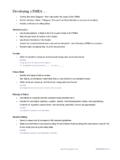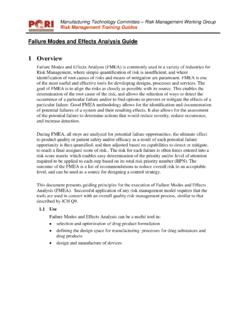Transcription of U FMEA FORPROCESSIMPROVEMENT INPATIENTSAFETY
1 9thAnnual Nursing Conference 2014 |NormahMedical Specialist Centre, Kuching Sarawak | 18-10-2014 The Evolving Standards of Care In NursingUSINGFMEAFORPROCESSIMPROVEMENTINP ATIENTSAFETYTINGCHINGCHINGPI MANAGERWHATYOUWILLKNOW: What an FMEA is The purpose of FMEA When to use it Understand the steps of the FMEA process How to use FMEA for improvement in patient safety FMEA in action: An exampleWHATISFMEA? FMEA stands forFailure Mode Effects analysis FMEAisa toolthat helps: Identify the ways that aprocesscan fail Why it might fail Determine the effects of that failure Prioritize potential failures for further action FMEA is proactive, systematic, & team-based FMEA does notfixfailuresWHATISTHEGOALOFFMEA? Usethe prioritized failure /risks to focus ourimprovementefforts on the most pressing problems-Predict possible failures-Eliminate the possibility of intolerable errors-Minimize the consequences of unavoidable errors Makesasystemmorefail-proof ReduceoreliminaterisktothepatientWHENDOY OUUSEANFMEA?
2 FMEAis an earlypart ofprocessimprovementRCAexamineswhyaspeci ficfailureoccurUse FMEAto improvean existingsystemWHENDOYOUUSEANFMEA?WHYDOFM EAINHEALTHCARE? Accident prevention has been a primary focus ofhospital medicine Misguide reliance on faultless performance byhealthcare professionals Hospital systems were not design to prevent error;they just reactively changed and were not Specimen identification Hospital-acquired condition-pressure ulcers,patient falls, wrong-site surgery, etc. Medication safety and dispensing Fall prevention Tests-delays and results Infection control Facility or new process design A prioritized list of potential failures/risksthat include:-What will we see when a failure occurs-How that failure impacts our customer -What is likely cause of the failures Best for analysis ofa systemnot an incidentWHATWILLANFMEAGIVEUS?THEFMEA PROCESSFMEA PROCESSSTEPS Selectprocesses with high potential for having anadverse impact on the safety of individualsservedHighRisk ProcessHealthcare Variableinputs Humans Complex Many processes Non-standardized Many lacks standard Heavily dependent on humaninteraction High degree of humaninteraction Hierarchical (not team)based VeryhierarchicalSTEP1: all candidates for considerationHIGH-RISKPROCESSES-EXAMPLES Medication administration Surgery Transfusion Restraints Isolation Emergency or resuscitative care High-risk population Team Leader FMEA Facilitator Recorder Experts on the process examined:-If clinical at least 1 nurses & 1doctor Include all areas involved in the process Hospital leader with decision-making power Outsider objective, na ve 6to10 members okSTEP2: FORMATEAMSTEP3.
3 MAPTHEPROCESS Pick a manageable portion of the process Make sure the topic is narrow enough of afocus(don t try to cure world hunger) Define beginning and end of the process-If process is complex, identify the area to focus on Chartthe processas it is normally done, using thecollective process knowledge of the team. Number each stepPROCESSFLOWCHART ANEXAMPLEC ardiacCathLab First Case Start Process Flow:STEPS4-6: USETHEFMEA WORKSHEETSTEP4:BRAINSTORMINGPOTENTIALFAI LUREMODES3 Things:A. What will weobservewhen something fails?B. How will the failureimpactour customer ?C. What do we think mightcausethis failures?4A. WHATERRORSORFAILURESWECANSEE? Foreach stepin the process, listall the failure modes-all the ways the process could break down or go wrong-could have multiple failures for each process stepProcessStepFailure Mode#4 failure Mode#3 failure Mode#2 failure Mode #14B. WHATARETHEEFFECTS? What are the consequences of the failure ? Review each failure mode and identify the potentialEffect(s) for each one Try not to overlook any Effects-> results willimpacts the risk ratings done laterIf failure mode occurs,then what are theconsequences?
4 4C. WHATCAUSESTHEFAILURE? What causes this failure mode? Is the reason or source of problem straightforward? If the root of the problem is not obvious, do RootCause analysis (RCA) Use appropriate root-cause analysis tools, 5-Why s STEP5: STARTRATINGS, O & D S, O, D :Severity, Occurrence, Detectability Need to have a scale to reference (1 10) 1 is best and 10 is worst Rate 1 through 10 to each of Severity, Occurrence,& Detectability Customize the scale to your organizationRATINGSEVERITY ANEXAMPLE: (1)Minor (2)Moderate (3)Major (4)Extreme (5)Patient SafetyPatient Experience Occurrence:How often does it happen?1 Never happens5 50% of the time, the failure happens10 100% of the time, the failure happens Detectability:How oftencan the system detect the failure ?1 Can never detect at all5 50%detection10 100%detection (fool-proof) SeverityXOccurrenceXDetectability The risk Priority Number determines where our greatestdanger liesGETTHERISKPRIORITYNUMBER(RPN)STEP6: PRIORITIZEBYRPN Prioritize your efforts and improvement resourcesaccording to RPN High RPNsare more serious, should be addressedfirst, and deserve more effort and resources Note that functions withlow RPN s might oftenhave none as the recommended action unless theaction were particularly easy and low cost Use the RPN to determine where to focus your limitedresources We arelooking for failures that are most severe, occuroften, & are hard to Mode(What youobserved when a failureoccurs)RPNRankIllegible handwriting1683 Look alike drugname ordered3601 Used felt pen on form544 Non formulary drug ordered2102 failure ModeHOWTOPRIORITIZEPOTENTIALFAILUREMODES ?
5 All failure modes areimportant, yetgive priorityattention & efforts on majorfailure modes Brainstorm action that could address the failuremodes with the highest Risk Priority Number(RPN)-Eliminate risk if possible-Minimize/mitigate risk if it cannot be eliminated-Look for opportunities to failure proof STEP7:REDESIGNTHEPROCESS/DESIGNCONTROLS To reduce risk is to reduce the Risk Priority Number(RPN)-Can I make this failureless severe?-Can I make this failureoccurs less often?-Can I make this failureeasy to detect?HOWCANWEREDUCETHERISKFORFAILURE?R EDUCESEVERITY EXAMPLES: Protection-gloves, masks, face shields Emergency shut-offs, fail-safe operation Sprinkler system, fire doors Patient positioning Alternative material, , safety glass, Pyrex Warning and message Backup and redundant systems Patient and family awareness and education Expanding supplier base, multiple sources Shared design with vendorsPREVENTOCCURRENCE EXAMPLES: Continual improvement, problem-solving teams Increasing process performance (capability) Address multiple causes Move checks earlier in the process Staff education & training Error-proofing Better data collection, publish data Protective storage, inventory management Supplier evaluation and monitoringIMPROVEDETECTABILITY EXAMPLES.
6 In-process checks instead of post-process Automated checks and early warnings Barcodes, wristbands, asking name/DOB Better measuring devices, calibration checks Verification & double-checks Use colors, shapes to identify materials Statistical process control (SPC) Equipment & process validations Audit, system testing & monitoringSTEP8: IMPLEMENT& EVALUATETHENEWPROCESS KEYSTEPS Important:Assign a person responsible for eachaction item, and a due date completion Follow-up on assigned actions Verify actions taken have intended resultsEVALUATENEWPROCESSWITH1 MOREFMEAA fter implementation: Determine what actions were taken-different thanproposed? Collect data on the new process Calculate new RPNsbased on actions taken Reassess RPNs and determine next actions (on sameitem if RPN is still high, or new high RPN)STEP9: MONITOREFFECTIVENESSOFPROCESS At regular intervals, re-assess to ensure the new processremains in place and effective Words first( failure Mode, Effects, Cause) Number second(Severity, Occurrence, Detectability)TIPSFORFILLINGOUTANFMEA failure Mode Effects analysis (FMEA) is aneffectiveproactive risk reduction technique Doing it right result inreducing patient harm &improving patient outcomesSUMMARY9thAnnual Nursing Conference 2014 |NormahMedical Specialist Centre, Kuching Sarawak | 18-10-2014 The Evolving Standards of Care In NursingInfection Prevention ApproachesSpeaker: Healthcare Associated Control Care : CDC GuidelinesInstitute of Health Improvement (IHI)Healthcare Associated Infection (HAI).
7 -Infection that appeared 2 days/48hrs following admission, theinfection was not present or incubating at the time of includes infection that appear within 2 weeks of hospitaldischarge, 30 days post surgery, within 1 year with implant use andoccupational infections among hospital staffBackground-Estimates that million HAIs occurred in hospitals in 2002and were associated with approximately 99,000 5-10% admitted to hospitals develop infections-Usually related to procedure or treatment,inappropriate patient care practices-About 25% can be prevented by taking proper precautions whencaring for patientsStudy of the Efficacy ofNosocomialInfection Control (SENIC): Significant proportion of HCAI can be prevented and the quality of infectioncontrol program makes a difference Hospitals with comprehensive infection Control program were ableto reduce the rate of HCAI by 32% over a period of 5 years Hospitals with poor or non-existent infection control program, therate of HCAI increased by 18% over the same periodImpact of HAI-Leads to functional disability & emotional stress-Disabling conditions reduce the quality of life-One of the leading cause of death-The increased economic cost are high: extra investigations,increased length of hospital stay (SSI days), extra health care effortby doctors & nursesImportant Types of HAIs-Use of invasive devices and procedures to treat patients and to help themrecover-Infections can be associated with the devices used during procedures, such ascatheters , HAIs include: Central line-associated bloodstream infections A small portion of HAI,approx.
8 5%, but case fatality rates are high Catheter-associated urinary tract infections-40% of total HAI Ventilator-associated pneumonia-the leading cause of death among HAIs. Surgical site 15%, a significant problem which limitspotential benefits of surgical interventions. The impact of hospital costs &post operative length of stay is Resistant Microorganisms Resistant to multiple antibiotic-MRSA, VRE, MDRO, TB Overuse & inappropriate use of antibiotic Reduce options for treatment Require isolation precautions Solutions: appropriate antibiotic use, better infection control &preventionCDC works to monitor and prevent these infections because they are animportant threat to patient pathogens: Bacteria Commensalbacteria, Pathogenic bacteria Virus HIV, HBV, HCV transmitted through blood & body fluid-Respiratorysyncytalvirus, Rota virus, Ebola, Influenza,Herpes Simplex virus Fungi opportunistic organisms and cause infections during extendedantibiotic treatment & severeimmuonsuppressionBacterial Survival times on hands: Acinetobacterspp60 min E.
9 Coli 6 min (mean) Klebsiellaspp2 min (mean) VRE 62 min Pseudomonasspp30 min;180 in sputum Rotavirus 16% survive 20 min2% survive 60 minIt s Alive, It s AlivePatient Susceptibility Age Infants & old age have lower resistance to infection Immune status Patient with chronic illness such as malignancy, leukemia,diabetes mellitus, renal failure or AIDS have higher susceptibility to infection Immunosuppressive drug, irradiation Where do infection transmission come from?-Endogenous infection: normal flora change to pathogenic due to change ofhabitat, damage of skin & inappropriate antibiotic use-Exogenous cross infection: Mainly through hands of healthcare workers,visitors & patientsEnvironmental Factors Healthcare environment where both infected persons & persons at high riskof infection congregate Crowded conditions within hospital patient, family members, visitors, HCW Microbial flora may contaminate objects, devices & materials whichsubsequently be in contact with susceptible body sites of patients.
10 Several types of microorganism survive well in hospital environment:Acinetobacter, Pseudomonas, Mycobacterium in damp areas,detergent & disinfectant, equipment & supplies, in fine dust & dropletnuclei Some procedures that save life may increase risk of infection urinarycatheter, intravenous therapy, inhalation therapy Inappropriate use of antibioticsBREAKTHECHAINT ransmission is easier to control than the source / hostInfection Control Prevention of HAI is the responsibility of all individuals & services provided byhealthcare settings To practice good Asepsis, oneshould always know what is dirty,what is clean, what is sterile andkeep them separate Hospital policies & procedures arefollowed to prevent spread ofinfection in hospitalInfection Control Program A comprehensive, effective & supported program is essential forreducing infection risk and increasing hospital safetyInfectionControlprogramInfectionCo ntrolManualInfectionControlCommitteeInfe ctionControlTeamInfection Control Team The structure varies with hospital types, needs & resources Hospital can appoint epidemiologist or infectious disease specialist,microbiologist to work as Infection Control Chairman Infection Control Nurse who is interested and has experience in infectioncontrol issuesEmpowered Team should have authority to manage an effective control program Team should have direct reporting with Senior Administration Team members are responsible for day to day functions of Infection Control& prepare yearly work planInfection Control Committee It includes representatives from different hospital departments &management, meeting monthly It establishes standards for patient care, it reviews & assesses InfectionControl reports.






